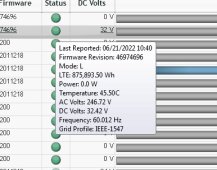I paid nearly $50K for this setup so the least I can do is invest time into it before pouring more money into it.
Right now, I'm pretty convinced the main problem is a software one and not necessarily a hardware one.
I simply don't agree with your thoughts of junking everything. That is a total waste of resources and even against the idea of trying to be more earth friendly by using solar maybe

. It's an unfortunate way of doing things whereas if someone here were educated on this manager, they could almost instantly know how to re-start most of this system.
I guess I don't understand why installers would not be all over manufacturers. Some of you are blaming the hardware as failure prone and junking it when it's in fact poor programming. In my case, I think this is a software issue that no one with pantheon will ever admit to.
These are the facts.
The system was generating precisely 0KW when I started this a few weeks back.
When I started, the manager found 0 inverters but since playing with it and re-scanning, I've now found 38 of the 42 panels.
Now it's generating over 2KW
solely by working on the manager tells me that there are two things I need to confirm.
The last service person that was up there may have messed up some of the wiring because it seems like it's partly a wiring issue.
I believe that the manager is disabling the output of the inverters. I believe this because I was able to get some to start generating again just by using a plc command which enables or disables output to grid.
# plcgridctl -s 201051335000746 -g 2 -f 1
There are also a LOT of other PLC control commands so saying the hardware is junk is not accurate because they are software controlled.
You can control every aspect of these things such as voltage inputs, phase, voltage outputs, all kinds of delays, warnings, it's a very long list but I cannot find any documentation of course.
In addition, the manager clearly shows that they are generating power, just not outputting it.
I can see that the inverters are getting a good voltage range input, they just aren't outputting that.
The inverters are MPPT 18V-37V so here is an example.

This is the case with most of them. I got the manager to see most of the inverters again and many are getting 0 DC voltage so potentially dead panel but others are getting a good DC voltage but as you can see, Power is 0.0W, they aren't putting the power out. That's a software issue.
If the inverter was dead, it would not be giving me all of this information, it would simply not even communicate.
I'd like to confirm that before spending yet more on this but as I said, I will likely be converting at least half of it to non grid tied. Just have to investigate first then know what's next.





